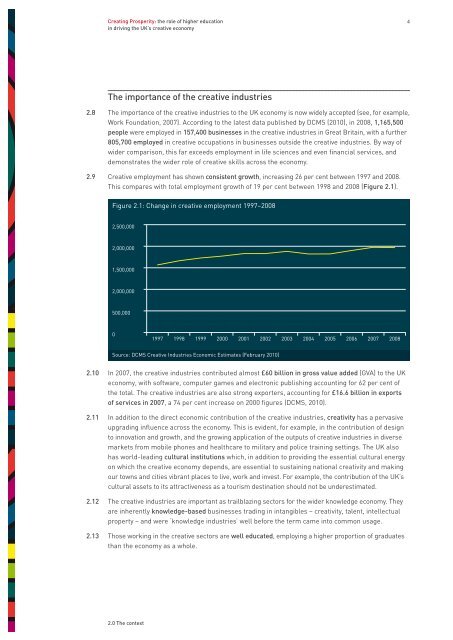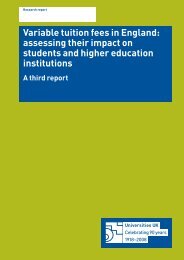Creating Prosperity: the role of higher education in ... - Universities UK
Creating Prosperity: the role of higher education in ... - Universities UK
Creating Prosperity: the role of higher education in ... - Universities UK
Create successful ePaper yourself
Turn your PDF publications into a flip-book with our unique Google optimized e-Paper software.
<strong>Creat<strong>in</strong>g</strong> <strong>Prosperity</strong>: <strong>the</strong> <strong>role</strong> <strong>of</strong> <strong>higher</strong> <strong>education</strong><strong>in</strong> driv<strong>in</strong>g <strong>the</strong> <strong>UK</strong>’s creative economy4The importance <strong>of</strong> <strong>the</strong> creative <strong>in</strong>dustries2.8 The importance <strong>of</strong> <strong>the</strong> creative <strong>in</strong>dustries to <strong>the</strong> <strong>UK</strong> economy is now widely accepted (see, for example,Work Foundation, 2007). Accord<strong>in</strong>g to <strong>the</strong> latest data published by DCMS (2010), <strong>in</strong> 2008, 1,165,500people were employed <strong>in</strong> 157,400 bus<strong>in</strong>esses <strong>in</strong> <strong>the</strong> creative <strong>in</strong>dustries <strong>in</strong> Great Brita<strong>in</strong>, with a fur<strong>the</strong>r805,700 employed <strong>in</strong> creative occupations <strong>in</strong> bus<strong>in</strong>esses outside <strong>the</strong> creative <strong>in</strong>dustries. By way <strong>of</strong>wider comparison, this far exceeds employment <strong>in</strong> life sciences and even f<strong>in</strong>ancial services, anddemonstrates <strong>the</strong> wider <strong>role</strong> <strong>of</strong> creative skills across <strong>the</strong> economy.2.9 Creative employment has shown consistent growth, <strong>in</strong>creas<strong>in</strong>g 26 per cent between 1997 and 2008.This compares with total employment growth <strong>of</strong> 19 per cent between 1998 and 2008 (Figure 2.1).Figure 2.1: Change <strong>in</strong> creative employment 1997–20082,500,0002,000,0001,500,0002,000,000500,0000199719981999200020012002200320042005200620072008Source: DCMS Creative Industries Economic Estimates (February 2010)2.10 In 2007, <strong>the</strong> creative <strong>in</strong>dustries contributed almost £60 billion <strong>in</strong> gross value added (GVA) to <strong>the</strong> <strong>UK</strong>economy, with s<strong>of</strong>tware, computer games and electronic publish<strong>in</strong>g account<strong>in</strong>g for 62 per cent <strong>of</strong><strong>the</strong> total. The creative <strong>in</strong>dustries are also strong exporters, account<strong>in</strong>g for £16.6 billion <strong>in</strong> exports<strong>of</strong> services <strong>in</strong> 2007, a 74 per cent <strong>in</strong>crease on 2000 figures (DCMS, 2010).2.11 In addition to <strong>the</strong> direct economic contribution <strong>of</strong> <strong>the</strong> creative <strong>in</strong>dustries, creativity has a pervasiveupgrad<strong>in</strong>g <strong>in</strong>fluence across <strong>the</strong> economy. This is evident, for example, <strong>in</strong> <strong>the</strong> contribution <strong>of</strong> designto <strong>in</strong>novation and growth, and <strong>the</strong> grow<strong>in</strong>g application <strong>of</strong> <strong>the</strong> outputs <strong>of</strong> creative <strong>in</strong>dustries <strong>in</strong> diversemarkets from mobile phones and healthcare to military and police tra<strong>in</strong><strong>in</strong>g sett<strong>in</strong>gs. The <strong>UK</strong> alsohas world-lead<strong>in</strong>g cultural <strong>in</strong>stitutions which, <strong>in</strong> addition to provid<strong>in</strong>g <strong>the</strong> essential cultural energyon which <strong>the</strong> creative economy depends, are essential to susta<strong>in</strong><strong>in</strong>g national creativity and mak<strong>in</strong>gour towns and cities vibrant places to live, work and <strong>in</strong>vest. For example, <strong>the</strong> contribution <strong>of</strong> <strong>the</strong> <strong>UK</strong>’scultural assets to its attractiveness as a tourism dest<strong>in</strong>ation should not be underestimated.2.12 The creative <strong>in</strong>dustries are important as trailblaz<strong>in</strong>g sectors for <strong>the</strong> wider knowledge economy. Theyare <strong>in</strong>herently knowledge-based bus<strong>in</strong>esses trad<strong>in</strong>g <strong>in</strong> <strong>in</strong>tangibles – creativity, talent, <strong>in</strong>tellectualproperty – and were ‘knowledge <strong>in</strong>dustries’ well before <strong>the</strong> term came <strong>in</strong>to common usage.2.13 Those work<strong>in</strong>g <strong>in</strong> <strong>the</strong> creative sectors are well educated, employ<strong>in</strong>g a <strong>higher</strong> proportion <strong>of</strong> graduatesthan <strong>the</strong> economy as a whole.2.0 The context
















